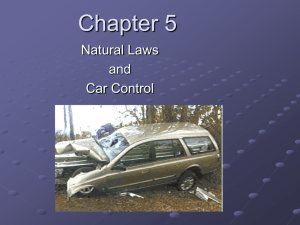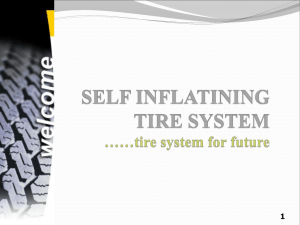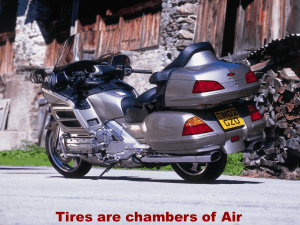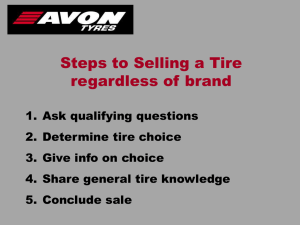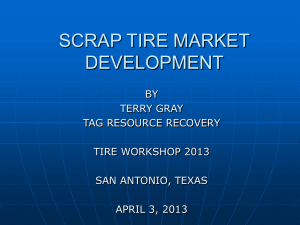Tire, Wheel, and Wheel Bearing Fundamentals
advertisement
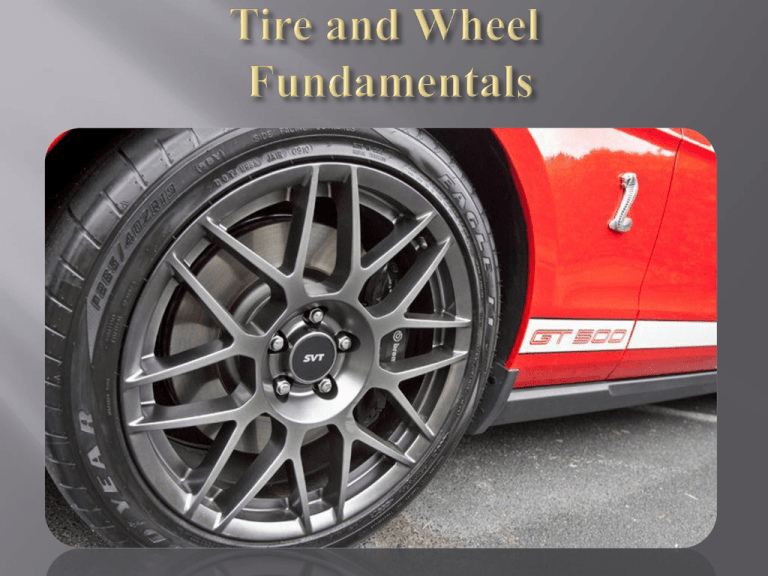
• 1. 2. • Automobile tires perform two basic functions: They act as soft cushion between the road and the metal wheel. They provide adequate traction (friction) with the road surface. Tires must transmit driving, braking, and cornering forces to the road in both good and bad weather. • • • • The tires on early vehicles were solid rubber. Today’s automotive tires are pneumatic, which means they are filled with air. Internal air pressure pushes out on the inside of the tire to support the weight of the vehicle. Tubeless tires - do not have a separate inner tube. The tire and wheel form an airtight seal. • Inner tubes (soft, thin, leak proof rubber liner) that fit inside the tire and wheel assemblies. • Beads- two rings that are made of steel wire and encased in rubber. They hold tire sidewalls snugly against wheel rim. • Body Plies- Rubberized fabric and cords wrapped around beads. They form the carcass, or body of the tire. • • • Tread- Outer surface of the tire that contacts the road. Sidewall- Outer part of the tire that extends from the bead to the tread. Markings on the sidewall provide information about the tire. Belts- Sometimes used to strengthen the body plies and stiffen the tread. They lie between the tread and plies. • • • It is measurement of the amount of friction produced as the tire operates on the road surface. A high rolling resistance would increase fuel consumption and wear. Rolling resistance can be reduced by higher inflation pressure, proper tire design, and lighter vehicle. • 1. Three types of tires that are found on late-model vehicles: Bias Ply tire – the plies run at an angle from bead to bead. The angle is reversed from ply to ply. The tread is bonded directly to the top of the ply. Bias ply is one of the oldest designs and does not use belts. The position of the cords allows the body of the tire to flex easily. A bias ply tire provides a very smooth ride on rough roads. • • • Is a bias ply tire with belts added to increase tread stiffness. The plies and belts normally run at different angles. The belts do not run around to the sidewalls- they lie under the tread area only. Belted bias tire provides a smooth ride and good traction. It also offers some reduction in rolling resistance over a bias ply tire. • • • • Has plies running straight across from bead to bead, with stabilizer belts directly beneath the tread. The belts can be made of steel, fiber-glass, or other materials. It has very flexible sidewall and a stiff tread, giving it a very stable footprint(shape and amount of tread touching road surface). This improves safety, wear , cornering , and braking. The tread area does not give or flex as much on rough roads. • The sidewall of a tire gives information about tire size, tire model, load-carrying ability, inflation pressure, number of plies, speed rating, manufacturer. E.G. P185/45R18 • Tire size- Given in alpha numeric sequence (e.g P 185 or LT 185) The letter “P” indicates that it is used on passenger car. The first number 185 gives section width in millimeters. Notice the next three-digit number: 185.. This number means that the tire is 185 mm at its section width--that is, from the outside of the tire wall all the way across to the outside of the opposite wall • • • The second Number 80 is the aspect ratio or height to width ratio. The smaller the number the more squat (wider and shorter). • This the comparison of the tire’s height (bead to tread distance) and width (sidewall to sidewall distance). A 80– series tire, for example, has an aspect ratio of 80; the height of the tire is 80% of the width. A 70- series tire would be “shorter and wider” • • The “R” indicates radial tire B indicates belted bias ply and D indicates bias ply • The last Number P225/45R18 shows the rim diameter in inches 14” 15” 16” rim (not metric value) • Load rating indicates the amount of weight a tire can carry at the recommended inflation pressure. Most alpha numeric tires are load range B. which is a 4 ply tire. Load Range B Ply Rating 4 C 6 D 8 E 10 F 12 Abbrevia Max Load ted Pressure B 35 psi (240 kPa)*** C 50 psi (350 kPa)*** D 65 psi (450 kPa)*** E 80 psi (550 kPa)*** F 95 psi (650 kPa)*** ***Selected large LT sizes are designed with reduced maximum load pressures • • • • • Is the maximum allowable sustained road speed a tire can safely withstand without failure. Speed ratings range from B ( 50 KM/H) to Z (238 KM/H). It is important that the speed rating of a tire be higher than the speed at which it will be driven. It too low of a speed rating is used, the tire could fail and cause a fatal accident. Note: automotive industry added W- and Y-speed ratings for vehicles that have extremely high top-speed capabilities. W 168 mph 270 km/h Y 186 mph 300 km/h • Are used to indicate a critical amount of tread wear. When too much tread has worn from the tires, solid rubber bars will show up across the tread. This means tire replacement is needed. Legal limit 2/32nds of tread. • • Is an extra wheel and tire assemble that can be installed if the vehicle has a flat tire. The spare can be a full size tire or a compact tire. • Full size spare- is a tire of the same size and type used on the other 4 wheels of the vehicle. It can be mounted and used like any other tire. • Compact spare or space saver- is much smaller than the normal tire used on the vehicle. It saves space in the trunk or storage area. • These tires have a coating of sealing compound applied to there liners. If an object (nail, screw) punctures the tire, air pressure will push the soft compound into the hole to stop air leakage. • • • Can detect both high and low tire pressure. In these systems, wheel sensors are mounted on each wheel. If tire pressure is not correct, the wheel sensor produces a radio signal. The signal is picked up by a small receiver that turns on a dash warning light to inform the driver. The sensors can be mounted by a band that wraps around the rim or attached to the valve stem. Note: be careful when dismounting a tire that has a tire monitoring sensor. The tire machine can damage the sensor • • Are design to support the tire while withstanding loads from acceleration, braking, and cornering. The can be made from steel, cast aluminum or magnesium. Mag. wheels or mags, is a nickname for aluminum or magnesium wheels • • • Commonly used on passenger vehicles because it allows for easier installation and removal of the tire. Since the centre of the wheel is smaller or (dropped) than the rim, the tire bead can fall into the recess. The other side of the tire bead can be forced over the rim for removal. • • • Has small ridges that hold the tire beads on the wheel during a tire blowout.(instant rupture and air loss). Small raised lips around the rim keep the tire beads from sliding into the drop-centre section. This improves safety by keeping the tire from coming off the wheel. • • • • Vale stem is pressed into a hole in the wheel of a tubeless tire to allow inflation and deflation. The stem is made from rubber. A threaded metal tube is formed into the end of the stem. The valve core is a spring-loaded air valve that is threaded into the valve stem. The valve core allows air to be added to the tire using an air chuck. When the chuck is removed from the valve stem spring pressure pushes the valve closed to prevent air leakage. • They hold the wheel and tire assembly on the vehicle. They fasten to a special wheel stud. The inner face of the lug nut is tapered to help centre the wheel on the hub. • • Metric nut- metric threads will be identified with an M or the word metric on the lug nut. Left hand nuts- These will be marked with a L on the nut • Question what manufacture used left hand lug nuts? • • They are small lead weights that are attached to the wheel rim to balance the wheel-and-tire assembly. This weights prevent vibration by offsetting a heavy area of the wheel and tire. They are used in ounces or grams e.g. 50 grams Stick-on Mag. Steel • Static Balance tire is placed in its vertical axis on a nonrotating spindle tool. The spot on the tire where the mass is greatest is acted on by gravity to deflect the tooling downward • Dynamic Balance These forces are resolved into static and couple values for the inner and outer planes of the wheel, and compared to the unbalance tolerance.
